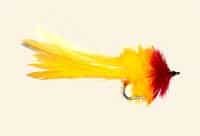
Weed Guards
One drawback to fishing in the shallows is that fish tend to hang out in some grassy spots. This means that we anglers have to worry about keeping our hooks foul-free or face the chore of defoliating our flies constantly. Depending on whom you talk to, there are several ways to keep a fly “weedless.” Actually, a better term would be “mostly weedless” because no method is foolproof, and if it were, it would also be fishless. Tiers use everything from monofilament to wire to special patterns, like bend-backs, all with varying preference and success.
The fact is that almost all of them work equally well, but some lend themselves better to certain patterns. Regardless of what material you use to make the guard, just remember it must be flexible enough to allow the fish to bite it and still get hooked. That is the one major complaint many anglers have with bend-backs, although if tied correctly a bend-back functions about as well as any other style of guard. Simple guards can even be tied in after the fact, and, of course, any weed guard can be removed if desired.
Whatever material you use to make guards, use as light a weight as you can get away with in the conditions you’ll be fishing. Many tiers use 30- to 40-pound mono for looped weed guards, but go much heavier for straight-style guards. Wire guards can be tricky because they sometimes need to be tuned to ride and work properly. Bend-backs, of course, work only as well as they are designed and tied. If you keep getting bit but don’t seem to be able to set the hook, lighten or even change the style of guard.









